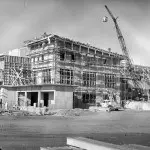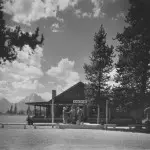In 1955 the Jackson Lake Lodge opened and became the first example of modern, International style architecture in a National Park. The design was intended to express a sense of modernism and the creation of a new era after the close of World War II. The large, flat, concrete and glass structure was made to blend in with the landscape as much as its Rustic style predecessors, but the use of mass-made manufactured materials sent a different message. It reflected the strength of the economy, that the war had not depleted the country’s resources, and the nation was able to increase production. The Jackson Lake Lodge was seen as a symbol of economic growth and success, ushering in a new era of architectural design in the Mission 66 program. The Lodge was intended to keep National Parks in the forefront of American culture and tourism, another boost to the post-war economy. The Lodge also offered modern amenities that many dude ranches had not yet adopted. As a resort, the Jackson Lake Lodge offered, and catered to, a very different type of vacation experience. The ability to drive the family automobile and see multiple sites at a time and rest in a comfortable room with electricity and plumbing was becoming expected. The National Park Service was mindful of their future in the minds of the American public and hoped to adopt the modernistic values of “progress, efficiency, health and innovation.”
The Jackson Lake Lodge is operated by the Grand Teton Lodge Company. Backed by John D. Rockefeller, Jr., it had originally been situated located in the nearby homesteader-settled town of Moran. Ben Sheffield first opened the Teton Lodge in 1903. It was run by the Teton Lodge Company, which became the Grand Teton Lodge Company when Rockefeller purchased the majority of the town in 1929. With few options for tourist housing in the valley, Rockefeller decided to keep the town of Moran and the Teton Lodge operational. He began working on plans to construct the new hotel with the nationally recognized architect Gilbert Stanley Underwood in 1950. Over the next five years until the Lodge was opened, the town of Moran was removed from the landscape and moved about 11 miles to the west. The remaining land was regraded and re-vegetated, removing all traces of its former location. The “ramshackle” town was an eyesore in the planned view shed planned for the new Lodge. Many of the original cabins built by Sheffield were moved to Colter Bay, and those that were in rough shape were burned.
The differences between the old Teton Lodge and the new Jackson Lake Lodge were stark and the new Lodge had many early detractors. A number of valley residents saw it as outlandish, cold and unfeeling. It lacked the warmth and traditional craftsmanship of the earlier log cabins. It catered specifically to tourists and the growing wealth of the middle class. Many locals felt it was intended only for outsiders, and held none of the cultural value associated with the history of the valley; clearly the idea of modern architecture had not yet penetrated the aesthetic senses of the general populace. Rather than distract from the outside, the building was designed to “bring the outside in.” An appreciation of the view was only possible when standing inside the lobby behind the large plate glass wall of windows. Supporters were quick to point out that the steel, concrete and glass structure was fireproof. In 2003, the Lodge was designated as a National Historic Landmark for its contributions to the modernization of National Park Service infrastructure. This is the highest level of designation that a historic building can receive, the Murie Center near Moose is the only other National Historic Landmark in the valley.
Despite the prominence of the Jackson Lake Lodge, the legacy of the Rockefellers, and the early successes of the Sheffields in Moran, many forget that there was a precursor that stood on the same spot. The “old” Jackson Lake Lodge was built in 1922 and owned by Eugene Amoretti’s Amoretti Hotel and Camp Company. Originally, this Lodge was considered to be the first modern hotel in the valley. The main lodge and many of the log cabins had both hot and cold running water, with full bathrooms. The cabins and lodge were purchased by Rockefeller’s Snake River Land Company in 1930, and kept operational until 1953 when the resort was demolished.
While no evidence remains of the original town of Moran, or the original Jackson Lake Lodge, their memory is not forgotten. Today’s Jackson Lake Dam Picnic area and associated parking lots are built on top of the site of the old town of Moran. For those with a keen eye, some hidden clues remain in the form of leftover strawberry plants, and pieces of concrete that have emerged through layers of soil due to the freeze-thaw cycle. The “ghost of Moran” is rumored to be nearby in the form of an old rhubarb plant that escaped the extensive regrading activities. Now considered a historic resource, the Jackson Lake Lodge continues to be one of the most visited areas in the valley, carrying on a legacy first created by Ben Sheffield over a century ago.
Text by Samantha Ford, Director of Historical Research and Outreach

